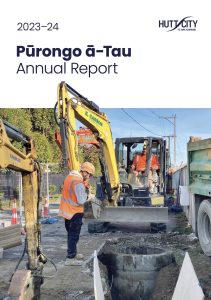This post is part of a series where I break down key highlights from the Hutt City Council’s 2023-24 Annual Report. My goal is to make council work more accessible and show you what we’ve actually achieved over the past year—not just what we plan to do.
The Tupua Horo Nuku Eastern Bays Shared Pathway is an exciting and transformative project for Lower Hutt, designed to provide a safer, more resilient route for pedestrians and cyclists along the Eastern Bays coastline., while at the same time protected the road from the harbour. While still in its early stages, this pathway marks an important step toward creating a more connected and resilient waterfront, giving our community a safer way to walk, cycle, and enjoy the stunning coastline that defines this part of our city.
In November 2023 we opened the first completed section of Tupua Horo Nuku at Ma-koromiko between Oruamotoro (Days Bay) and Eastbourne. In the same month we were pleased to receive confirmation of additional government funding of $15 million for the new seawall and shared pathway project, which stretches 4.4km along Marine Drive between Ngau Matau (Point Howard) and Eastbourne.
Why the Pathway is Important for Lower Hutt
The Eastern Bays coastline has long been prone to natural hazards, with erosion, sea-level rise, and storm surges posing increasing risks to this area. The Tupua Horo Nuku project addresses these issues by building a pathway that includes vital resilience upgrades, making the coastline safer for everyone who uses it. It’s about more than just adding a footpath—it’s a commitment to safeguarding our community from the risks posed by a changing climate.
Key Objectives of the Project:
- Improved Safety for All Users: The pathway provides a dedicated space for cyclists and pedestrians, reducing the risk of accidents and conflicts with vehicles along busy, narrow coastal roads. This enhancement makes it safer for people of all ages to use the pathway, from schoolchildren to older residents.
- Increased Resilience Against Natural Hazards: Tupua Horo Nuku is designed to withstand coastal hazards, from high tides to severe storms. By incorporating erosion control and sea wall features, the pathway will serve as a barrier against coastal erosion, helping to protect nearby properties and roads. While they have been constructing the pathway, they have found several sink holes hidden under the road that have been eroded away from the ocean underneath.
- Enhanced Recreation and Accessibility: For residents and visitors alike, the pathway offers an accessible route to enjoy the coastline. Creating this shared pathway aligns with the city’s broader goals to promote health and wellbeing, encouraging walking and cycling as part of daily routines.
What We’ve Achieved So Far
The first phase of the pathway has been successfully completed, laying the groundwork for further development in the coming years. This initial phase included extensive preparatory work to stabilise the coastline and create a base for the pathway that can withstand future developments and potential hazards.
Beyond physical construction, a significant part of the work has involved extensive community consultation to ensure the project meets local needs. By working closely with residents and stakeholders, the council has tailored the pathway to serve not only as a safe route but also as an integrated part of the community. You can find more about the progress and costs involved in the Annual Report on page 28.
What’s Next for Tupua Horo Nuku?
While Phase 1 has wrapped up, the project is far from over. Future stages will extend the pathway further along the coastline, providing even greater protection and accessibility. These developments are planned over the next few years, aligning with Lower Hutt’s Long Term Plan, which outlines a decade of further improvements. For more information on what’s planned, you can check out our Long Term Plan here here.
Investment and Funding
Creating a pathway of this scale and quality requires considerable investment. The project has been made possible through funding partnerships with national agencies focused on coastal resilience and safety, as well as significant contributions from local council funds. By directing resources to this project, the council is prioritising long-term safety and accessibility for Lower Hutt’s residents and visitors.
If you’re interested in the project’s details, progress updates, and financial breakdown, see page 28 in the 2023-24 Annual Report here.
